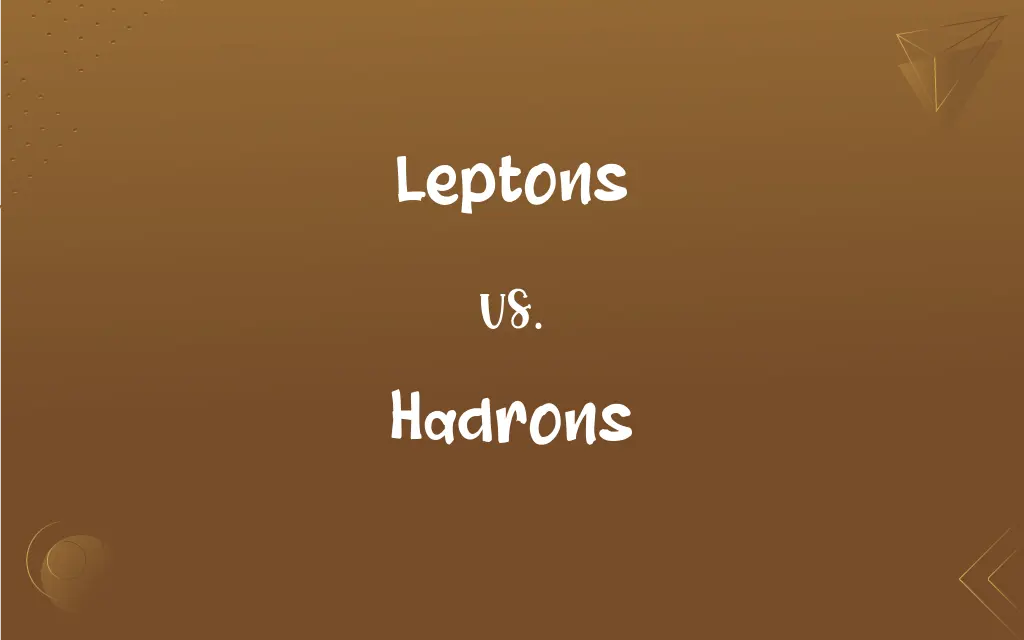Leptons vs. Hadrons: What's the Difference?
Edited by Aimie Carlson || By Janet White || Published on January 29, 2024
Leptons are fundamental particles like electrons, not subject to strong nuclear forces, while hadrons are composite particles, like protons and neutrons, that interact through strong forces.

Key Differences
Leptons are elementary particles, which means they are not composed of smaller particles. Examples include electrons and neutrinos. In contrast, hadrons are composite particles made up of quarks, bound together by the strong nuclear force. Protons and neutrons are the most familiar hadrons.
In terms of interaction, leptons only participate in weak and electromagnetic interactions and are not affected by the strong nuclear force. On the other hand, hadrons are directly involved in strong nuclear interactions, which is the force that binds them together within atomic nuclei.
There are six types of leptons, categorized into three generations: the electron, muon, and tau particles, and their corresponding neutrinos. Conversely, hadrons are classified into two broad categories: baryons, like protons and neutrons, and mesons, which are quark-antiquark pairs.
Leptons are characterized by their small mass (with neutrinos being nearly massless) and stability, with electrons being stable and others decaying into lighter particles. Hadrons, especially baryons, are generally more massive than leptons and can be stable (like protons) or unstable (like most mesons).
In the Standard Model of particle physics, leptons are one of the main building blocks of matter, alongside quarks. Hadrons, being made of quarks, are also essential components of matter, particularly in the atomic nucleus.
ADVERTISEMENT
Comparison Chart
Composition
Fundamental particles
Composite particles made of quarks
Interaction with Forces
Weak and electromagnetic only
Strong nuclear, weak, and electromagnetic
Types
Six types (electron, muon, tau, and their neutrinos)
Baryons (like protons and neutrons) and mesons
Mass and Stability
Generally lighter and stable
Heavier, can be stable or unstable
Role in the Standard Model
Basic building blocks of matter
Essential in forming atomic nuclei
ADVERTISEMENT
Leptons and Hadrons Definitions
Leptons
Elementary particles categorized into three generations.
The muon is a heavier lepton compared to the electron.
Hadrons
Subject to strong nuclear, weak, and electromagnetic forces.
The strong nuclear force binds quarks together in hadrons.
Leptons
Particles that include electrons and neutrinos.
Neutrinos, being leptons, are elusive and rarely interact with matter.
Hadrons
Crucial components of atomic nuclei in matter.
Hadrons, particularly protons and neutrons, compose the atomic nucleus.
Leptons
Particles known for their small mass and stability.
The stability of electrons, which are leptons, is crucial for atomic structure.
Hadrons
Include baryons and mesons in particle classifications.
Protons, a type of baryon hadron, are positively charged particles in the nucleus.
Leptons
Constituents of matter, fundamental in particle physics.
Leptons play a key role in the Standard Model of particle physics.
Hadrons
Composite particles made of quarks, interacting via strong force.
Protons and neutrons, both hadrons, form the nucleus of an atom.
Leptons
A fundamental particle not subject to the strong nuclear force.
The electron, a lepton, orbits the nucleus of an atom.
Hadrons
Particles with varying stability, some being very short-lived.
Pions, a type of meson hadron, are unstable and decay rapidly.
Leptons
Any of a class of six elementary fermions, two in each of the three generations of fundamental fermions (one negatively charged and one neutral), and including the electron, electron neutrino, muon, muon neutrino, tauon, and tauon neutrino, together with their associated antiparticles, the antileptons. Leptons participate in weak interactions, but not strong interactions, and have masses generally less than those of mesons and baryons.
Hadrons
Any of a class of subatomic particles that are composed of two or three quarks and participate in strong interactions. The class of hadrons is divided into the mesons and baryons.
Leptons
Plural of lepton
Hadrons
Plural of hadron
FAQs
What are hadrons?
Hadrons are composite particles, like protons and neutrons, that interact through strong forces.
What are the two main categories of hadrons?
Hadrons are categorized into baryons, like protons and neutrons, and mesons, which are quark-antiquark pairs.
What are leptons?
Leptons are fundamental particles, like electrons, not subject to strong nuclear forces.
Can hadrons be unstable?
Yes, many hadrons are unstable, particularly mesons, which decay rapidly.
Do hadrons interact with light?
Yes, hadrons can interact with light through electromagnetic interactions.
How many types of leptons are there?
There are six types of leptons, including electrons, muons, tau particles, and their respective neutrinos.
Do leptons participate in strong nuclear interactions?
No, leptons do not participate in strong nuclear interactions, only in weak and electromagnetic interactions.
Are leptons more or less massive than hadrons?
Leptons are generally less massive than hadrons, with neutrinos being nearly massless.
What role do leptons play in the atom?
Electrons, which are leptons, orbit the nucleus of an atom and play a key role in chemical bonding.
Are neutrinos, a type of lepton, easy to detect?
Neutrinos are notoriously difficult to detect because they rarely interact with other matter.
What is the most common hadron in the universe?
The proton is the most common and stable hadron in the universe.
Do leptons have an electric charge?
Some leptons, like electrons, have a negative charge, while neutrinos are electrically neutral.
Are mesons, a type of hadron, stable particles?
Most mesons are unstable and decay into other particles within a very short period.
What binds the quarks in hadrons?
Quarks in hadrons are bound together by the strong nuclear force.
Are all hadrons found in the atomic nucleus?
Baryons, a type of hadron, are found in the nucleus, but mesons are typically not part of atomic nuclei.
What is the significance of hadrons in physics?
Hadrons are essential for understanding strong nuclear forces and the structure of atomic nuclei.
How do leptons contribute to the mass of an atom?
While leptons contribute to the mass of an atom, their contribution is relatively small compared to hadrons in the nucleus.
Can leptons decay into other particles?
Some leptons, like muons and tau particles, can decay into lighter leptons and other particles.
Are leptons affected by gravity?
Yes, like all particles with mass, leptons are affected by gravity.
Can hadrons be created in particle accelerators?
Yes, hadrons are routinely produced and studied in high-energy particle accelerators.
About Author
Written by
Janet WhiteJanet White has been an esteemed writer and blogger for Difference Wiki. Holding a Master's degree in Science and Medical Journalism from the prestigious Boston University, she has consistently demonstrated her expertise and passion for her field. When she's not immersed in her work, Janet relishes her time exercising, delving into a good book, and cherishing moments with friends and family.
Edited by
Aimie CarlsonAimie Carlson, holding a master's degree in English literature, is a fervent English language enthusiast. She lends her writing talents to Difference Wiki, a prominent website that specializes in comparisons, offering readers insightful analyses that both captivate and inform.































































